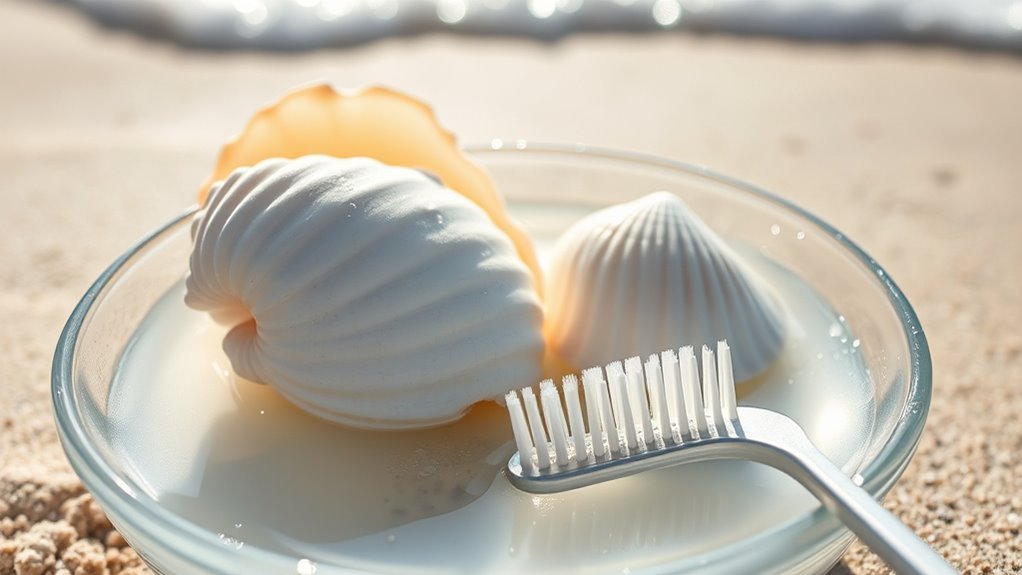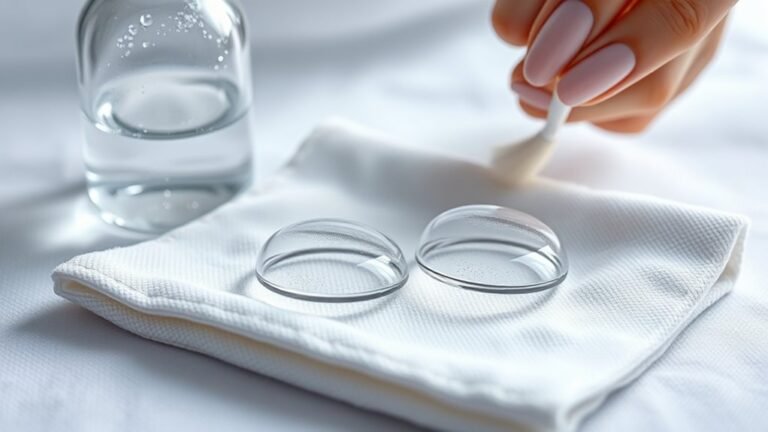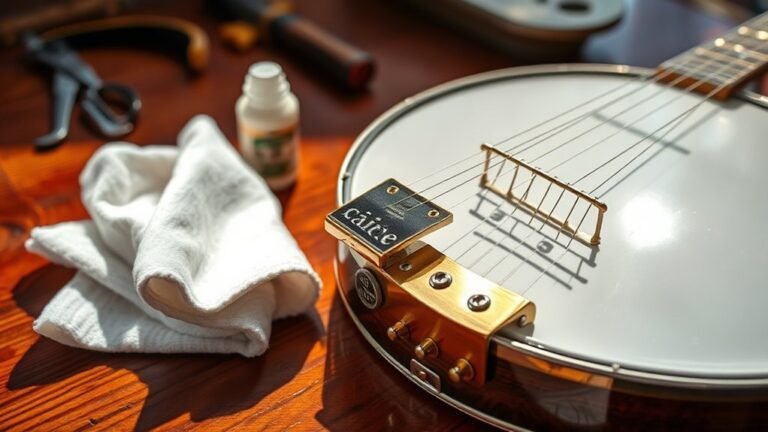How Do You Clean Shells From the Ocean
To clean shells from the ocean, first rinse them under cool running water to remove dirt. Use a soft brush for stubborn residues on calcium carbonate shells. For shells with barnacles, soak them in equal parts water and white vinegar. If they’re delicate, use a mild soap solution with a soft cloth. After cleaning, rinse thoroughly to eliminate any residues and let them air dry completely. Exploration of specific cleaning techniques can enhance your shell collection.
Preparation For Cleaning

Before you plunge into cleaning those beautiful ocean shells, it’s essential to gather the right materials and prepare your workspace. Start by organizing your shell collection on a clean, flat surface, ensuring you have good lighting. You’ll want to have access to fresh water, a soft brush, and a gentle mild soap for effective cleaning methods. Avoid harsh chemicals that can damage the shells’ natural luster. It’s also wise to have a container for rinsing and drying the shells after cleaning. Take your time to inspect each shell for any remaining debris or marine life; this initial preparation will help you achieve the best results. By ensuring your workspace is ready, you’re setting the stage for a successful cleaning experience.
Tools and Chemical Required

Having your workspace ready sets the foundation for the cleaning process, but the right tools and chemicals are equally important. Depending on the shell types you’ve collected, different cleaning methods may be necessary. Here’s a quick reference table to help you choose:
| Tool/Chemical | Purpose |
|---|---|
| Soft brush | Removes debris gently |
| Toothbrush | For intricate designs |
| White vinegar | Dissolves organic matter |
| Baking soda | Deodorizes and cleans |
Gather these items before you start, ensuring your cleaning process will run smoothly. Using the correct tools and chemicals not only protects the shells but also maximizes their beauty, allowing you to showcase your findings with pride.
How to Clean:

How to Clean Ocean Shells: A Step-by-Step Guide
Cleaning ocean shells can be a rewarding process that allows you to showcase their natural beauty. Follow this detailed guide to ensure your shells are cleaned effectively and safely.
Step 1: Rinse the Shells
- Start by rinsing your ocean shells under cool running water.
- Use your hands to remove any surface dirt and sand.
- Make sure to rinse all areas of the shell for thorough cleaning.
Step 2: Identify Shell Types
- Determine the type of shell you are cleaning. Common types include calcium carbonate shells (like clams and scallops) and more delicate varieties.
- Knowing the shell type will help you choose the appropriate cleaning method.
Step 3: Scrub Stubborn Residues
- For calcium carbonate shells:
- Use a soft brush (like a toothbrush) to gently scrub the surface.
- Focus on areas with stubborn residues, ensuring you don’t damage the shell.
Step 4: Soak for Barnacle Removal
- If you encounter barnacles or other adherent materials:
- Prepare a solution of equal parts water and vinegar.
- Soak the affected shells in this mixture for a few minutes.
- This will soften the barnacles, making them easier to remove.
Step 5: Clean Delicate Shells
- For delicate shells, avoid using harsh chemicals or abrasive materials.
- Instead, create a simple soap solution:
- Mix a few drops of mild dish soap in warm water.
- Use a soft cloth or sponge to gently wipe the shell, being cautious not to apply too much pressure.
Step 6: Rinse Thoroughly
- After cleaning, rinse each shell thoroughly under cool running water.
- Ensure that all soap, vinegar, or cleaning solution residues are completely washed away.
Step 7: Dry the Shells
- Allow your cleaned shells to air dry completely.
- Place them on a clean towel or drying rack in a well-ventilated area.
- Make sure they are fully dry to prevent any mold growth or damage.
Step 8: Enjoy Your Cleaned Treasures
- Once dry, your ocean shells are ready to be displayed or used in crafts.
- Admire the beauty of your hard work and enjoy showcasing your beautifully cleaned treasures!
Safety Consideration
Cleaning ocean shells can be enjoyable, but it’s important to prioritize safety during the process. Before you plunge into shell collecting, consider some essential safety precautions. Always wear gloves to protect your hands from sharp edges and potential contaminants. Stay aware of your surroundings; watch for any incoming tides or unstable surfaces that could pose risks.
While collecting, practice beach etiquette by respecting local wildlife and avoiding any protected areas. Remember, some shells may harbor bacteria or parasites, so rinse them thoroughly with freshwater after collection. If you notice any unusual smells or signs of decay, it’s best to discard those shells. By following these guidelines, you’ll guarantee a safe and enjoyable shell-cleaning experience that respects both nature and your well-being.
Frequently Asked Questions
Can I Use Bleach to Clean Ocean Shells?
You shouldn’t use bleach for shell cleaning, as it can be harmful to both the shells and your health. Bleach can weaken the shell’s structure and strip away natural colors. If you’re looking for a safe alternative, consider using a mixture of vinegar and water or baking soda. These methods are effective at removing debris and keeping your shells intact, allowing you to enjoy their beauty without the risks associated with bleach safety.
How Do I Remove Barnacles From Shells?
To remove barnacles from shells, soak them in warm, soapy water for about 30 minutes. Use a soft brush to gently scrub away the barnacles, taking care not to damage the shell. If stubborn, a plastic scraper can help. After barnacle removal, rinse thoroughly and dry the shells. For best shell care, avoid harsh chemicals and store them in a cool, dry place to maintain their beauty and integrity.
Are There Any Shells I Shouldn’t Collect?
You shouldn’t collect shells from endangered species or those protected by law. Ethical collecting is essential for preserving marine ecosystems. Before you pick up a shell, research local regulations and species conservation status. Avoid shells that are homes to living creatures or contribute to habitat destruction. By being mindful and informed, you can enjoy your shell collection while respecting the environment and helping maintain the delicate balance of ocean life.
How Can I Preserve the Color of Cleaned Shells?
To preserve the vibrant color of your cleaned shells, you’ll want to apply a clear shell coating, like acrylic sealer or polyurethane. These coatings not only protect against fading but also enhance the natural hues. Think of it as giving your shells a shield against time. After cleaning, make sure the shells are dry before applying the coating. This way, you can enjoy their beauty for years without worrying about color preservation fading away.
What Is the Best Way to Display My Cleaned Shells?
The best way to display your cleaned shells is through creative arrangements that highlight their unique shapes and colors. Consider using shadow boxes or glass display cases to protect them while allowing light to enhance their natural beauty. You can also arrange shells on driftwood or create a themed tableau that reflects your beach experiences. Grouping shells by size or color can create visually appealing shell displays, making your collection a stunning focal point in any room.






